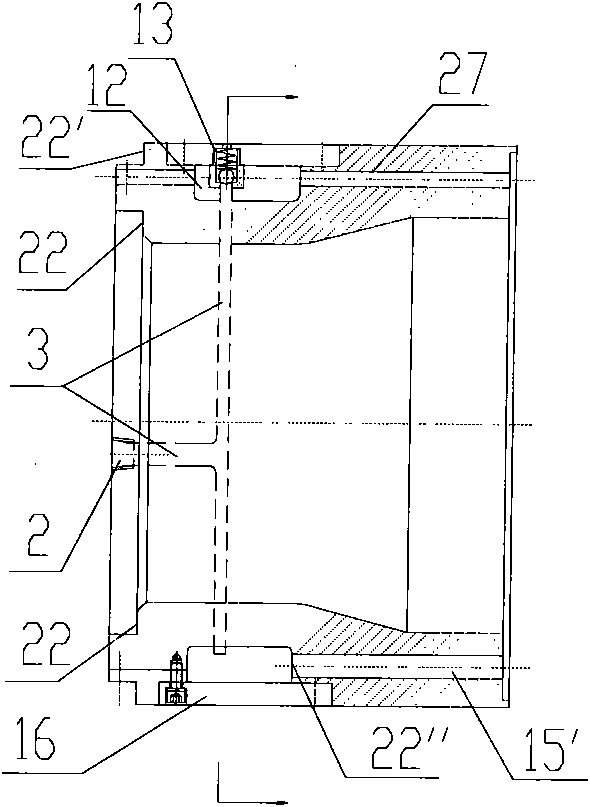[0002] At present, there are many mature technical equipment and construction methods in variable cross-section piles or extruded and expanded limb piles, rammed (pressed) expanded piles, and special-shaped piles at home and abroad: one is the extruded and expanded pile, and the representative pile types are as follows: The extruded and expanded limb disc pile adopts the cross-use of drilling, special extruder expander, and bottom cleaning, which greatly improves the
bearing capacity (pullout resistance) of the cast-in-place pile, and has obvious
economic benefits. It is a relatively frontier in China. However, there are three sets of equipment that are used alternately. After the hole is formed, the number of times of repeated
extrusion and expansion is large, and sometimes the hole collapses. Ideal, the adaptability of the soil layer is limited to a certain extent, and there are disadvantages such as a large amount of mud removal and a long single pile construction period; the second is the hammer type rammed and expanded pile and static pressure expanded pile technology, only one expansion plate is set at the end, which is relatively There are high requirements for setting depth and soil layer, and the practical range is narrow; the third is artificial hole reaming or high-pressure water (including
cement slurry or other chemical
slurry)
punching expansion technology, which is manually excavated and expanded into disks or high-pressure water
impact cutting into holes after hole formation. It is difficult to increase the load-
carrying capacity of the disk, and the result is twice the result with half the effort; the fourth is the mechanical
cutting type, the
cutting tool that will be installed on the rotating arm rod, under the strong force of the rotating arm, will gradually
cut the surrounding soil into a cylindrical disk with a certain height and
diameter , the bearing capacity of this method is slightly improved; the fifth is the blasting
extrusion expansion pile, which is extruded into a big
head shape by using the
explosive force of the explosive, and its applicable area is limited and the shape is not easy to control; the sixth is the foreign Simplex pile (Simplex pile) and Frank
Pile (Franki pile), similar to domestic rammed and expanded piles, is forced to extrude conical pile shoes and fillers by hammering the inner tube, or impacts fillers by
free fall of cylindrical steel hammer until the enlarged head of the pile end is formed; the seventh is Japan Kubota Iron Works Co., Ltd.'s special reaming equipment (can be made into multi-section discs), adopts three-in-one drilling, rotary
extrusion reaming and bottom cleaning to implement multi-disk cast-in-place piles, but the equipment is expensive and applicable to the range of soil
layers Narrow and small; Eighth, Japanese steel
fiber prefabricated fully threaded piles, the whole pile body is a threaded structure, which is convenient to increase the friction area with the soil and improve the bearing capacity of the single pile, but the
energy consumption of the equipment is too large, and the increase in the bearing capacity of the single pile is not enough Ideal; Ninth is the screw-extruded cast-in-situ pile invented in China. The main principle is to use special equipment to squeeze the soil into a thread shape, and pump concrete in the
pipe to form it, which expands the pile side friction area and improves the pile bearing capacity. The bearing capacity of the pile is improved in the suitable soil layer, but it is difficult to form in the soft soil and the effect is not obvious; the tenth is the automatic compander pile technology, which was invented by the applicant in 2006 and the static
pile driver This device, which can realize multiple expansion plates of the pile body, is used in conjunction with the sinking tube grouting pile type, and the common problems of
necking and jacking of the pile body caused by excessive
pore water pressure cannot be completely avoided in soft soil
layers, and the pile length ≯20 meters, the construction method is to expand the panel from the bottom. If multiple expanded panels are implemented, the reinforcement cage cannot be placed, and it will become a plain concrete multi-disc pile. Its application range is limited, and there is no suitable interlayer in the middle of the soft soil layer When the bearing capacity of single pile is difficult to reach expectations
[0003] In summary, the safety and economy of pile foundations in soft soil areas are technical difficulties. Generally, PHC
pipe piles are used in soft soil for buildings with less than 20 stories, but the
metal welded joints and hollow section stiffness of PHC
pipe piles are inherently rigid. Insufficient durability, and its durability and
earthquake resistance also need to be improved. The number of single-column cap piles used in high-rise buildings is too large, the foundation volume is too large, the cost of the foundation part increases, and the
cost performance tends to be weak; the large-
diameter deep and long bored piles use mud Holes are formed in the
retaining wall, the requirements for mud production are relatively high, and the amount of mud discharged is large, especially the consumption and
pollution of
groundwater resources during construction is serious, and the site is poorly civilized and hygienic. There are certain limitations, and the bearing capacity of straight-rod cast-in-situ piles cannot have a qualitative breakthrough due to congenital defects such as the
critical depth of the pile and the pile size effect.
 Login to View More
Login to View More  Login to View More
Login to View More 


